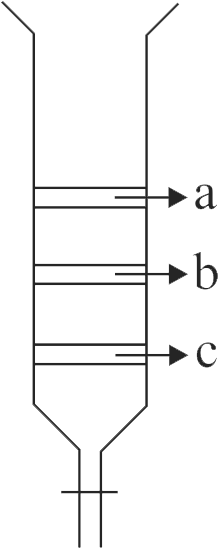317319
From the figure of column chromatography given below, identify incorrect statements.
A. Compound 'c' is more polar than 'a' and 'b'.
B. Compound 'a' is least polar.
C. Compound 'b' comes out of the column before 'c' and after 'a'.
D. Compound 'a' spends more time in the column.
Choose the correct answer from the options given below.
317319
From the figure of column chromatography given below, identify incorrect statements.
A. Compound 'c' is more polar than 'a' and 'b'.
B. Compound 'a' is least polar.
C. Compound 'b' comes out of the column before 'c' and after 'a'.
D. Compound 'a' spends more time in the column.
Choose the correct answer from the options given below.
317319
From the figure of column chromatography given below, identify incorrect statements.
A. Compound 'c' is more polar than 'a' and 'b'.
B. Compound 'a' is least polar.
C. Compound 'b' comes out of the column before 'c' and after 'a'.
D. Compound 'a' spends more time in the column.
Choose the correct answer from the options given below.
317319
From the figure of column chromatography given below, identify incorrect statements.
A. Compound 'c' is more polar than 'a' and 'b'.
B. Compound 'a' is least polar.
C. Compound 'b' comes out of the column before 'c' and after 'a'.
D. Compound 'a' spends more time in the column.
Choose the correct answer from the options given below.
